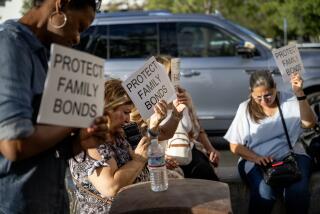Back story: Susan Straight’s familial bonds stand test of time
Biraderi.
The other night, my cellphone rang at one a.m. My nephew Sensei said, “Auntie. You told me to call.”
“Yup,” I said. “And?”
“I’m alive.”
“Excellent.”
Only two serious rules, my three daughters kept telling him: Don’t eat chocolate or red foods on the beige couch (why I bought a beige couch years ago is another story), and call at night so she knows you’re alive. Don’t blow that one.
My nephew came to live with us just as I was finishing “Take One Candle Light a Room,” a novel about a Los Feliz travel writer named Fantine Antoine who’s deliberately distanced herself from her rural family and refused to take in her orphaned godson, Victor. Fantine wants little to do with her past. She’s willing to send Victor expensive leather bags and postcards of Italian paintings, but she doesn’t want him to actually stay in her Art Deco apartment building.
My nephew had slept on our couch in Riverside many times. But permanent life was hard at my house. You had to be in school. There were chores. Those two rules.
I’d felt guilty about him, or I wouldn’t have been so obsessed with this novel, wouldn’t have realized it was really about clan. The tribe. Your people.
From a recent vivid essay on the Pakistan floods by Daniyal Mueenuddin, I learned “biraderi.” “An untranslatable word,” he wrote, “something like clan but more visceral and entailing greater responsibility and connection.”
I love this wordand keep saying it to myself. I’ve spent my life writing about the biraderi of black America, the way fierce, unshakable devotion to blood family and chosen familyhas kept children alive.
Sensei is my ex-husband’s oldest brother’s fourth son; his mother is a woman we’ve never met, who lives in another state. I am called “Auntie” by 21 nieces and nephews, 23 young cousins, and 18 great-nieces and -nephews who are babies and toddlers.
It seems complicated to outsiders. But it’s not. If you have ever been close to anyone in our huge extended family, we will feed you. Help you find a job. We have your back. Even after divorce: My ex and I were divorced 13 years ago. Even if you were never married: The woman Sensei still calls “Mom” is my “sister-in-law” Shirley, who kept him even when she wouldn’t speak to his father.
The biraderi aunts and uncles provide graduation money, rent money, baby shower gifts, tuition for college or cosmetology school. Sensei is a skateboarder, 6-2 and rail-thin with dreadlocks like black coral; he eats a lot of tacos and breaks a board every 10 days or so. But lying awake at night, doing the math on new skateboards and shoes (what do boys do to Vans?), worrying about having three kids in college and one in high school, I realize he’s a descendant of Geneva Stevenson. If not for Aunt Jennie, none of the young people sleeping under my roof would be here today.
Her house was on 21st and Central, just inside the boundaries of the original rancho lands of Los Angeles. The family legends are pared down here: Geneva Stevenson was born in Tennessee around 1890. Her mother, Fine, the orphaned child of a former slave woman and an itinerant Cherokee man, ran away from the white family she’d been “given” to in 1879. While picking blackberries so she could buy shoes, Fine met a young man, and soon Geneva was born, in a migrant labor shack. Fine ended up in Texas, where she married a mixed-race farmer and had another daughter named Callie. Geneva’s stepfather was so abusive that she fled the house when she was 14 or 15 and went to Tulsa, Okla.
In Tulsa, she made money any way she could; the men in our family recount speakeasies, Geneva dancing with a pistol in her bosom and never missing a step while bending to retrieve the gun if it fell. She was self-sufficient enough that when her stepfather died and white relatives took the land, Geneva sent for her mother and Callie.
She married Robert Stevenson in Tulsa, and later they moved to Los Angeles. But when Callie was left a widow with five children on a farm outside Tulsa, Geneva again sent for her kin.
She divided her attic into rooms with cardboard walls. All those children of her half-sister went to school and then worked. She charged them rent, but that house was a safe harbor, and as John Sims, Callie’s youngest son, remembers, “There was always food at Aunt Jennie’s house. We were so hungry in Tulsa, my mother lost the marrow in her bones and they sent her to the hospital.”
My father-in-law, General, was the wild one. His own mother once chased him down the alley behind Geneva’s house because he took her last dollars, and when someone shouted, “Are you going crazy!?” he turned, spread his arms and yelled back, “Yeah, you want to come?”
Decades later, his own house was full of nieces and nephews and cousins’ children and neighbors who needed a place to sleep or eat. He was brusque — but I never saw him turn anyone away.
I did a lot of driving around L.A. when working on the novel; at the Golden Gopher, downtown, Fantine hears about what happened to Victor’s mother, who was murdered in an alley behind a taqueria; Victor calls her to rescue him after a shooting outside a Burbank club called Dimples. To Fantine’s family, she has failed her kin, her people. Yet this time when Victor calls, she finally takes off to find him.
Several times while trying to write, I drove down Central Avenue and looked at Aunt Jennie’s place.
The ice house on the corner is now a recycling center. But her house is still there, the wood frame covered with stucco. Last year, Uncle Robert, Uncle John and his daughter Toni, my ex-husband Dwayne and me and our three girls parked near the wrought iron gate. A young woman came out, curious to see what we wanted, and after we told her about Aunt Jennie, she returned with the owner.
It was her aunt. A woman who’d immigrated from a tiny town outside Guadalajara, this aunt was raising her own family and a host of nieces and nephews. We sat in the shaded concrete driveway, two clans speaking different languages while looking at the outbuildings constructed back in the 1930s. The niece said the attic rooms were still hot.
Aunt Jennie taught Toni to tie her shoes there, when Toni was about 5. The cover of my new novel is an image created by Toni (Sims) Scott, who has illuminated our family’s resilience and loyalty in her installation at the California Afro American Museum’s Gallery of Discovery. Sculptures of ship-held slaves, a re-created slave cabin papered with oral narratives and our “Family Tree,” branches dangling photos from slavery through now. Aunt Jennie looks imperious, lovely in her fur collar, and I can imagine the pistol, the narrowed eyes and the sleeping kin.
Often when I was writing about Fantine, named for a young woman who applied her last piece of smoked meat to the fresh-burned brand on the shoulder of the young slave she called “sister,” it would be after midnight and every couch would be draped with teenagers. (The unmistakable crack crack of the wheels on the sidewalk, then the board parked by the front door; my girls hollering that Sensei had clearly applied too much Axe.)
I worry about the same things I imagine Aunt Jennie did — school, laundry, how many plates at dinner. But I have new ones — my nephew made his will at 13, after his two best friends were shot and killed. He has a skater’s penchant for breaking phones and fingers. Last night, someone pulled a gun on him while he skated with four friends. A grown man tried to rob them of boards and money, and he had to run. “I just wanted to come home,” he said in the doorway, shirt translucent with sweat.
I hope we are enough — the legacy of Aunt Jennie and General and all the members of the tribe, the biraderi: the faces around your table, in the candlelight, the ones with whom you can lay your head down by your empty plate and even cry, you are so relieved to be with them again.
Straight’s latest novel, “Take One Candle Light a Room,” was published Tuesday.
More to Read
The biggest entertainment stories
Get our big stories about Hollywood, film, television, music, arts, culture and more right in your inbox as soon as they publish.
You may occasionally receive promotional content from the Los Angeles Times.







